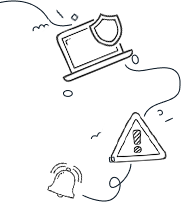Introduction
Phishing is the hot topic of the day, and no, it’s not just about the fish! As the most common method of cyber-threat, it’s a crafty way of playing on victims’ emotions to lure them into disclosing sensitive data. Think of it as the digital equivalent of a fishing lure – shiny, enticing, and full of hidden hooks!
While over 90% of cyberattacks begin with a phishing email, that’s just the tip of the iceberg. Phishers have cast their nets far and wide, exploring all sorts of creative ways to reach out, extort money, and collect personal information. Who knew phishers could be so industrious?
Have you ever received a voice phishing call? Also known as vishing, this sinister scheme goes mobile and takes place over a good old-fashioned phone call – yes, those relics of the past that you thought only your grandparents used!
Behind Vishing Calls
Picture this: a typical vishing call unfolds like a bad B-movie plot. The scammer makes their grand entrance with all the charm of a used car salesman. Typically armed with a spoofed number, they’ll make the call seem like it’s coming from your friendly neighborhood bank, a prestigious government agency, or a tech support hotline that doesn’t actually exist (because who needs to fix your grandma’s computer, right?).
The caller may introduce themselves as a representative from this spoofed organization, weaving together a web of trust by using personal information they already have about you—like your name, favorite pizza topping, or that embarrassing incident from high school (seriously, how did they find that out?). Then, they ramp up the pressure. “Your bank account is under suspicious activity!” they declare, or “You owe money to the IRS!” – all delivered with a dramatic flair that could make even the most seasoned actor jealous. It’s amazing what a little legal and financial trouble can do to one’s common sense!
The threat actor essentially plays the emotional card, coaxing you into coughing up sensitive information like your Social Security number, bank details, or those ever-elusive login credentials. Sometimes, they’ll even ask you to make a payment or transfer money faster than you can say, “Wait, who are you again?” Once the scammer has what they need, they can unleash their nefarious plans like a villain in a superhero movie (but without the cool costume).
How to Protect Yourself From Voice Phishing
- Verify the caller. If you get an unsolicited call, hang up faster than you’d hang up on a telemarketer. Then, contact the organization directly using a number you know – like the one on their official website (not the one they gave you, obviously).
- Be skeptical of any caller who speaks faster than a car sales pitch and seems to create a sense of urgency. “Time is money! Give me your personal info now or lose it forever!” If they don’t seem right, they probably aren’t!
- Don’t share personal information. Think of your private data like the secret recipe to your grandma’s famous cookies: precious and not meant to be shared with just anyone over the phone.
On another note, artificial intelligence can now create audio that sounds just like someone else’s voice – complete with their quirky quirks and intonations. It’s called deepfaking. So, if you hear a voice and it sounds like a mix between your long-lost uncle and a robot, contact the supposed person or organization through verified, encrypted channels – just in case.
When Has Vishing Actually Occurred?
Believe it or not, you might have encountered vishing more than you realize! Picture tax season rolls around, bringing with it fake IRS calls trying to scare you into believing you owe thousands. Remember, the real government will send official documents through *snail mail* – a term that describes the slowest delivery service imaginable!
Vishing doesn’t just target individuals; larger organizations can also find themselves in the crosshairs. A voice phishing attempt aimed at a single employee could impact the whole company – it’s like a classic game of dominoes where everyone ends up flat!
In December 2024, authorities in Spain and Peru busted a sophisticated vishing ring that had defrauded over 10,000 victims. These criminals used caller ID spoofing and scripts so smooth they could have sold ice to an Eskimo! Law enforcement conducted 29 raids, arresting 83 individuals and seizing cash, computers, and documents. It’s proof that large voice phishing operations can become quite extravagant—and reminds us that international cooperation is essential in the battle against all cybercrime!
Conclusion
Voice phishing is just one of the many cyber threats lurking in the shadows, waiting to catch you off guard. The more you know about these threats, the better you can protect your data (and your sanity!).
Remember, no one should ask you for sensitive information over the phone. Legitimate organizations and government departments shall never place you under pressure. If someone is trying to hurry you, slow it down like you’re in a traffic jam; take a moment to assess the situation.
Whether you receive a vishing call or encounter other forms of phishing or cyber threats, educating yourself is your most powerful weapon. The more you know, the faster you can respond and avoid these dramatic twists in your life’s plot! Keep your sense of humor and your wits about you!
The post Vishing: What Makes Voice Phishing So Effectively Dangerous? appeared first on .




